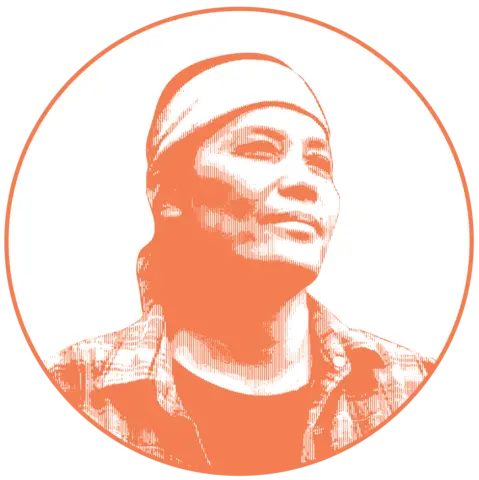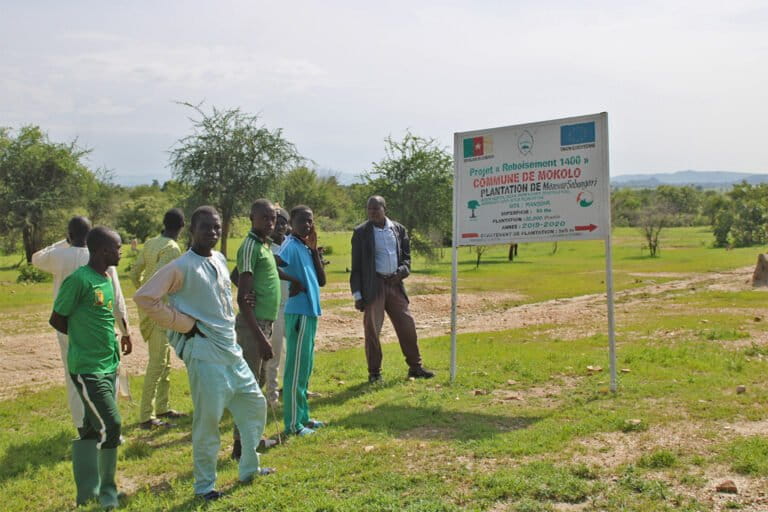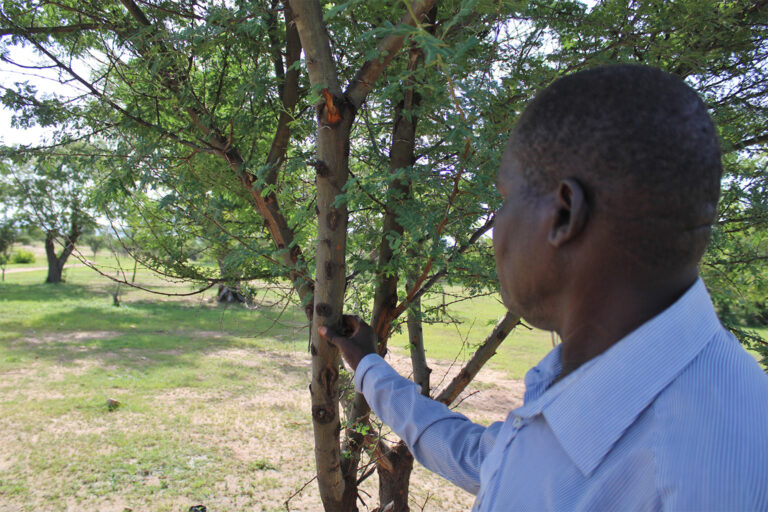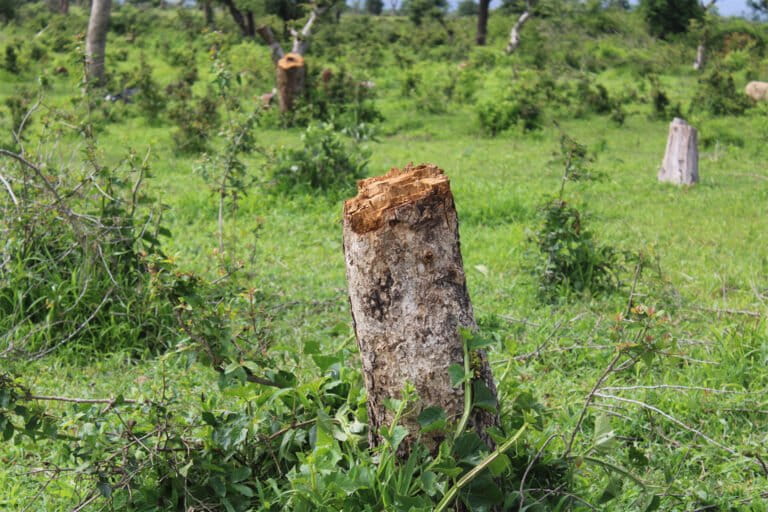This story was translated from French. To read the original story in full, visit Mongabay. You may also view the original story in English on Mongabay.

- Reforestation projects to restore degraded lands in Chad and Cameroon, like the “Great Green Wall” and the “Reforestation 1400” projects, are facing increasing pressure from logging activity.
- Facing poverty and corrupt local authorities, locals are cutting trees in new protected areas for firewood or to sell charcoal.
- Local environmental defence organizations, officials and administrations who lead these reforestation projects are raising the alarm about the extent of deforestation which is contributing to desertification in these areas.
- Despite alternative solutions to excessive logging being proposed and implemented, locals are still harvesting from reforested areas.
MOKOLO, Cameroon—The sun is already beating down this morning, a Saturday in July, at Mansour-Sabongari village.
Young locals sit chatting in the shade of a forest plantation developed by the Reforestation 1400 project. The project helped regreen the village’s landscape in northern Cameroon, a savannah with a very hot desert climate — much to the delight of local residents.
“Before, even during the rainy season, it was hot as soon as the sun came out. Now, we don’t feel the heat as much, and the trees can shade us from the sun,” says Idrissou Saliou, a local resident.

As a nonprofit journalism organization, we depend on your support to fund journalism covering underreported issues around the world. Donate any amount today to become a Pulitzer Center Champion and receive exclusive benefits!
Further out in Gaoui, near Chad’s capital N’Djamena, Roger Alkali relaxes in a reforested garden created by the Great Green Wall project. By 2030, the project aims to restore 100 million hectares (about 247 million acres) of degraded land across 11 African countries in the Sahel.
“We can breathe much cleaner air now than in other places. We are called to protect this green barrier to save us from the very hot climate,” says Alkali, a local resident.

Several initiatives, just like the Reforestation 1400 and the Great Green Wall projects, were launched in these two Central African countries with the aim of restoring deforested sites and combating desertification in the Sahel. As the climate heats up, changes in rainfall patterns can cause longer dry spells on the southern boundaries of the Sahara, stretching the desert further down, and affecting nearly a million people and their livelihoods.
But deforestation of newly reforested areas is a common challenge facing these projects scattered around this hot climate.
“Some people living nearby still come and secretly cut down trees for firewood,” Alkali shares with Mongabay.
Despite the notable progress of these projects, they still face significant challenges from various pressures, such as corruption, excessive tree felling for charcoal and wood production, as well as frequent bush fires. These factors represent significant threats to these reforested sites meant to combat the effects of deforestation and desertification in the first place.

Wood: a tool for survival
Steve Djelassem is a farmer in Gaoui who supplements his income with charcoal manufacturing, especially during the ‘hungry gap’ season — the hardest time for farmers when this year’s harvest isn’t yet ready, but last year’s food stocks have run out. To produce charcoal, he obtains large quantities of wood, cut at random, including from protected areas.
“Dead [dry] wood is very rare, which is why we have to cut green [fresh] wood to make charcoal. That’s how we earn money to support our families,” confesses the father of three, who is conscious of his activity’s harmful impact on the success of the Great Green Wall project.
He focuses on the “survival of [his] family”, in a country where 42% of the population lived below the poverty line in 2018, according to World Bank data.
Although the Great Green Wall initiatives began with a vision of a green barrier to stop desertification, over the years it has faced criticism over its lack of effectiveness on the continent. In Chad, the project aims to restore a grand 46 million hectares (113 million acres) of degraded land and store millions of tonnes of carbon to fight climate change, but has only restored about 1.2 million hectares (about 3 million acres) — or 2.6% of the total restoration area, project officials tell Mongabay.
The project vision has now evolved and its current aims are a blend of preventing aridification, combatting climate change and supporting local livelihoods and income through agriculture, beekeeping, agroforestry and animal breeding. However, reforestation challenges persist.
The project suffers setbacks from local residents who continue to cut down trees for charcoal due to a lack of affordable alternatives and people building residential houses on certain reforested sites as the population in an area grows.

Wood fuel is the main energy source for Chadian households, the vast majority of whom have limited income to afford domestic gas especially in the midst of inflation. The fight against tree felling is a challenge for the Chadian government authorities, despite the existence of a law prohibiting it.
The results of a 2011 survey on consumption and the informal sector carried out by the United Nations Development Program (UNDP), reveal that 88.6% of Chadian households use wood as their main energy source for cooking, and 10.9% use charcoal. According to the latest data from the Food and Agriculture Organization of the United Nations (FAO), the total consumption of woody biomass is on average 69 793 tonnes per year for the whole population.
Multiple seizure operations are regularly carried out by the Chadian Ministry of the Environment’s Forest and wildlife service agents, but these fail to dissuade locals from continuing to fell trees.
Many initiatives are being carried out by private operators to try to slow down wood cutting, like green charcoal, a solution launched in 2021 by a local start-up, KARÖ Entreprise. Using plant waste or agricultural residue to make charcoal, the company produces on average 800 kilograms (1,763 pounds) of green charcoal per day and sells it at lower cost to households. Green charcoal is thriving in certain Chadian households, says Ghislain Bandah Sanki, spokesperson of the new company.
“In N’Djamena, everyone who has bought our green charcoal no longer uses conventional charcoal,” he reveals.
But, he puts things into perspective: “Many people are still using charcoal due to lack of information and access to green charcoal, given the lack of financial means for awareness and large-scale production.”

In northern Cameroon, the use of firewood is equally worrying and contributes to the degradation of forest cover and further desertification. According to a recent study by the Center for International Forestry Research (CIFOR), around 80% of Cameroonians use wood for cooking, and 2.2 million metric tonnes are burned each year.
The scale of deforestation at the national level is best illustrated in the global forest monitoring platform Global Forest Watch, which reveals that Cameroon lost 1.8 million hectares (4.4 million acres) of its forest cover between 2001 and 2022, while Chad lost 605,000 hectares (about 1.5 million acres) over the same period, or 15% of its forest cover since 2000.

Lack of pay, lack of enforcement
Most of this wood used as a household energy source in northern Cameroon comes from protected areas, according to the non-profit organisation Forests and Rural Development (FODER).
The Reforestation 1400 project plantations have technically already more than doubled their 1,400 hectares (about 3,400 acres) reforestation target. But they are also grappling with how to secure their sites from incoming deforestation, being faced with underfunded local authorities who lack the resources to enfore laws.
“We are no longer able to monitor land restoration because there is not enough staff and there is no equipment to carry out land audits,” says Nira Gnokreo, water and forestry engineer serving at the delegation of the Cameroonian Ministry of Forests and Wildlife in the far north region.
A lack of resources is also a common problem for the Great Green Wall project in Chad.
Patricia Mbaïregogou Melom, head of communications at the National Agency for the Great Green Wall (ANGMV), tells Mongabay that the agency is in a difficult financial situation.
“We have not been able to carry out our field activities and haven’t been able to pay agents’ salaries since 2017,” she says. “This situation has seriously affected operational capacities and implementation of activities in the field.”

The lack of financial resources also poses difficulties in securing these reforested sites because it can provoke corrupt practices, according to the mayor of Mokolo, Vohod Deguime.
“When the eco-guards recruited at the start of a project aren’t being paid anymore, they start taking money from local residents to let them access sites to cut wood,” reveals the Mokolo councillor.
Eco-guard corruption also contributed to the decline of “Operation Green Sahel,” the oldest reforestation project in northern Cameroon, launched by the government in the 1970s.
According to an investigation published by Le Monde and InfoCongo, other forms of corruption are also at play. When illegal loggers enter forested areas to sell wood in the market, they are working with local elites, authorities, residents and traditional leaders. The cutting of targeted tree species lasts days, even weeks. In return, some farmers pay a financial sum to the entire village through the development committee or other local organisations representing residents.
Due to the difficulty of securing sites, the Zamay forest reserve in Mokolo is disappearing over time following the exploitation of its resources over the last ten years. This 3,500 hectare protected area extends to the town of Minawao, where a camp for Nigerian refugees, victims of Boko Haram terrorist attacks, has been set up since 2013.
Once settled in the camp, the refugees turned to the reserve and cut trees for firewood for cooking. This has become commonplace for the 78,000 refugees in the camp living in poverty, in the care of the United Nations High Commissioner for Refugees (UNHCR), and many other human rights organisations, explains Isaac Luka, spokesperson for the Minawao camp refugees.


The UNHCR, NGOs, local administrations, private individuals, get food, Luka tells Mongabay, but there are no energy sources to cook with.
“The refugees go to the Zamay reserve to cut down trees for cooking because wood is the only energy source, or use green charcoal that we are taught to make,” he says.
He admits that this influx of refugees onto the reserve has considerably contributed to its degradation, and regrets that the forest plantations created on the camp borders with the assistance of numerous environmental defence organisations are already suffering the same fate, despite reforestation awareness campaigns.
Mokolo town hall is responsible for securing this forest reserve and other reforestation projects carried out within the municipality. Beyond logging, these areas are also under permanent threat from bush fires and cattle breeding practiced in the region, which damage planted trees.
Last February, a fire ravaged nearly 40 hectares (about 98 acres) of the Reforestation 1400 project forest plantations in Mansour-Sabongari, “caused by hunters who use fire to capture small rodents hidden in the ground,” confides Katchala Ngadja, a technical assistant of the Reforestation 1400 project at the Mokolo town hall. These fires are then spread by the region’s strong winds.

What will put an end to logging?
According to Gilbert Haïna, teacher and researcher in environmental sciences at the University of Maroua, a storm of several factors is contributing to the failure of reforestation projects in Sahelian areas. These include strong population growth (which leads to an increase in resource consumption), a strong demand for wood consumption, poverty, the surge in domestic gas prices and slash-and-burn agriculture.
The environmentalist recommends public policies adapted to different countries, suggesting a system of intermittent rationed cutting, focused on cutting rotations.
“If we had vegetation around the villages, we could schedule cuts on the west side during a given year, then on the east side the following year, which would allow the vegetation to regenerate on both sides on alternate years,” he explains. This should be done while integrating better cutting techniques as clear cutting people are currently doing now contributes to the destruction of vegetation.”











